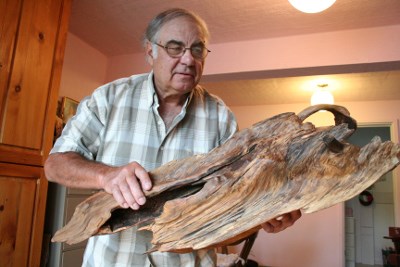Before nickel was discovered in Sudbury and mining began, the area was known for the white pine forest that towered above the ground. The community was called Ste. Anne of the Pines.
A retired Sudbury shop teacher is now producing art that hearkens back to that time.
Ron Romanko, 73, said he recently stumbled upon a white pine stump while blueberry picking. He believes it to be 300 years old.
“I found a white pine stump over four feet in diameter right here on the hills in the city. I could not count the rings as it was rotted out. About 150 feet away from the stump I found another piece that must have been part of the crown or top of the tree,” he said.
“It must have been a 200 year old tree when it was probably logged in the 1880s when the railway come through. That means the pieces I found are 300 years old.”
He estimated that due to the size of the stump, the tree must have soared over 150 feet high.
Romanko took the crown piece home, sanded it down and created what he considers a piece of natural art. He used simple tools-various grades of sandpaper, 40 to 120 grit sandpaper and a scraper to work with the wood and remove debris and loose material.
Then he used furniture polish to help preserve the wood. He estimated it took over 100 hours of work to restore the largest piece from the tree's crown.
He is proud of his work.
“There is not a person on the planet who could duplicate what nature did herself. The wood is hard after you take it down somewhat.”
Working with the old wood spurred an interest in the history behind the original tree and and the forest that must have towered above the ground, he said.
“This tree is part of our history. In the limited research I have done, I have found accounts that in Blezard Valley, there were white pine trees six feet in diameter. There was a real good stand of pines there.”
He said those pines were cut in a relatively short period.
“I have read the trees were cut in about 25 years. First there was the Chicago fire of 1871. That was the main culprit. They used to use log booms to float them down the rivers then across Lake Huron to mills in the USA,” he noted.
Early mining in Sudbury also used a lot of wood.
“I came across a statistic that the roaster beds used by Inco used 40,000 cords of white pine. In 1911, we were considered the turpentine capital of the world. We had thousands of pine stumps. They set them on fire and created turpentine out of them,” he said.
Romanko had more pieces he had retrieved in his garage.
“When I finish these I would like to make a display of these treasures from nature,” he beamed.
Join Sudbury.com+
- Messages
- Post a Listing
- Your Listings
- Your Profile
- Your Subscriptions
- Your Likes
- Your Business
- Support Local News
- Payment History
Sudbury.com+ members
Already a +member?
Not a +member?
Sign up for a Sudbury.com+ account for instant access to upcoming contests, local offers, auctions and so much more.
